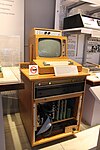História das bandeiras cristãs

A história das bandeiras cristãs abrange o estabelecimento de estados cristãos, a era dos cruzados e o movimento ecumênico do século XX.[1]
Bandeiras nacionais de países predominantemente cristãos[editar | editar código-fonte]

Impérios cristãos, como o Reino da Geórgia, que se tornou um Estado cristão em 337, adotaram o simbolismo cristão em sua bandeira.[3] Da mesma forma, as bandeiras do Império Bizantino frequentemente retratavam "uma tigela com uma cruz, símbolo do domínio mundano bizantino por séculos e da missão ecumênica de espalhar o Cristianismo em todo o mundo".[4]

Muitos estados oficialmente cristãos e países predominantemente cristãos têm bandeiras com simbolismo cristão. Muitas bandeiras usadas pelas nações modernas têm suas raízes nas bandeiras cristãs históricas usadas nos impérios cristãos históricos, como o Império Bizantino ou na vexilologia dos cruzados.[1] Todas as bandeiras baseadas no Dannebrog, incluindo a Bandeira da Finlândia, Bandeira das Ilhas Faroé, Bandeira da Islândia, Bandeira da Noruega e Bandeira da Suécia, contêm uma cruz cristã, representando o Cristianismo.[5][6] A União Jack da Grã-Bretanha, bem como suas bandeiras descendentes "faz referência a três santos padroeiros cristãos: o santo padroeiro da Inglaterra, representado pela cruz vermelha de São Jorge, o santo padroeiro da Irlanda, representado pelo salame vermelho de São Patrício e o santo padroeiro da Escócia, representado pelo saltire de Santo André."[7] Além disso, a bandeira da Grécia, bem como a bandeira da Suíça, contêm uma cruz cristã para representar a fé.[8] A "cruz na bandeira da Dominica representa o Cristianismo, enquanto as três cores em que a cruz consiste representam a Trindade" e o "brasão de armas representado na bandeira da Eslováquia mostra uma cruz dupla". A bandeira da República Dominicana também mostra uma Bíblia e uma cruz. A bandeira da Geórgia, a bandeira de Tonga, a bandeira da Moldávia e a bandeira da Sérvia exibem uma cruz representando o Cristianismo.[9] A bandeira de Portugal também possui simbolismo cristão, com as cinco feridas de Cristo.[10] A Bandeira da Cidade do Vaticano apresenta as chaves de São Pedro, que lhe foram dadas por Jesus Cristo, uma or (ouro) e uma argent (prata), que representam o poder celestial e terrestre, respectivamente. A bandeira também apresenta uma cruz cristã, que supera a tiara papal.[11][12]

-
Bandeira do Império Etíope
Na Idade Média, as bandeiras cristãs exibiam vários tipos de cruzes cristãs.[13] Ordens militares de cavaleiros cristãos usavam essas cruzes em suas bandeiras. Por exemplo, os Cavaleiros Hospitalários (Cavaleiros de Malta) usavam e continuam a usar uma cruz maltesa em suas bandeiras.
-
Bandeira da Ordem Militar Soberana de Malta (Cavaleiros Hospitaleiros)
-
Bandeira da Ordem Teutônica
-
Bandeira dos Cavaleiros Templários
-
Bandeira da Ordem de São Lázaro
Bandeiras de denominações cristãs[editar | editar código-fonte]
Muitas denominações cristãs têm sua própria bandeira denominacional e a exibem ao lado da bandeira cristã ecumênica ou independente dela.[14]
As igrejas católicas em comunhão com a Santa Sé costumam exibir a Bandeira do Vaticano, juntamente com sua respectiva bandeira nacional, geralmente em lados opostos do santuário, perto da porta da frente, ou hasteadas em mastros do lado de fora. As dioceses individuais também podem arvorar bandeiras com base no brasão diocesano.
A tradição da Igreja Ortodoxa Oriental, particularmente as jurisdições da Igreja Ortodoxa Grega sob a autoridade direta do Patriarca Ecumênico, costuma exibir essa bandeira. É uma águia bizantina de duas cabeças em um campo amarelo (Or).
As paróquias da Igreja Episcopal freqüentemente exibem a bandeira episcopal, uma cruz de São Jorge com o cantão superior esquerdo contendo uma cruz de Santo André formada por nove cruzamentos (representando as nove dioceses originais) sobre um fundo azul.
O Exército da Salvação tem uma bandeira com uma borda azul (simbolizando a pureza de Deus Pai), um campo vermelho (simbolizando o sangue de Jesus Cristo) e uma estrela de oito pontas dourada (simbolizando o fogo do Espírito Santo). A estrela tem o lema do exército da Salvação, "Sangue e Fogo".
A Comunhão Anglicana tem uma bandeira azul com uma cruz de São Jorge no centro, cercada por uma faixa de ouro com a frase "A verdade vos libertará". em grego do Novo Testamento . Da banda brotam os pontos de uma bússola (simbolizando a disseminação mundial do anglicanismo). No "norte" da bússola está uma mitra (um símbolo da ordem apostólica essencial a todas as igrejas e províncias que constituem a Comunhão Anglicana).
A Igreja da Escócia usa uma bandeira da Escócia representando o Burning Bush (ou Bush não queimado, em algumas tradições).
A Igreja no País de Gales usa uma cruz azul desfigurada com uma cruz celta dourada.
A Igreja da Irlanda usa o Saltire de São Patrício, mas também a Bandeira da Rosa dos Ventos da Comunhão Anglicana.
A Igreja Evangélica na Alemanha, uma federação de igrejas luteranas, reformadas e protestantes unidas, tem uma bandeira com uma cruz latina violeta.
Além disso, muitas igrejas católicas, protestantes e ortodoxas mantêm o uso do lábaro, um símbolo histórico do cristianismo, que atualmente raramente é usado como uma bandeira.
-
Bandeira da Igreja Ortodoxa Grega
-
Bandeira da Igreja Ortodoxa da Geórgia
-
Bandeira da Igreja Episcopal
-
Bandeira da Igreja Ortodoxa Sérvia
-
Bandeira da Igreja Apostólica Armênia
-
Padrão do Exército de Salvação
-
Bandeira da Comunhão Anglicana
-
Bandeira da Igreja Ortodoxa da Albânia
-
Bandeira da Igreja de Gales
-
Bandeira da Igreja da Escócia
-
Bandeira da Igreja da Irlanda
-
Bandeira da Igreja Anglicana da Austrália
-
Bandeira da Igreja Anglicana do Canadá
-
Bandeira da Igreja Evangélica na Alemanha
-
Bandeira da Igreja Evangélica na Alemanha (versão alternativa)
Bandeira Cristã adotada pelo Conselho Federal de Igrejas[editar | editar código-fonte]

Nos primórdios do movimento ecumênico no final do século XIX e início do século XX,[15] a Bandeira Cristã foi concebida pela primeira vez em 26 de setembro de 1897, na Capela de Brighton, em Coney Island, no Brooklyn, Nova York, nos Estados Unidos. O superintendente de uma escola dominical, Charles C. Overton, deu uma palestra aos alunos reunidos e perguntou aos alunos como seria uma bandeira ecumênica representando todo o Cristianismo.[16] Em 1907, Overton e Ralph Diffendorfer, secretário do Movimento Missionário dos Jovens Metodistas, projetaram e começaram a promover a bandeira.[17] A bandeira cristã intencionalmente não tem patente, pois o designer dedicou a bandeira a toda a Cristandade.[18] No que diz respeito ao simbolismo cristão da bandeira cristã:
O chão é branco, representando paz, pureza e inocência. No canto superior está um quadrado azul, a cor do céu sem nuvens, emblemático do céu, a casa do cristão; também um símbolo de fé e confiança. no centro do azul está a cruz, o estandarte e símbolo escolhido do Cristianismo: a cruz é vermelha, típica do sangue de Cristo.[16]

A organização ecumênica, Conselho Federal de Igrejas, agora sucedido pelo Conselho Nacional de Igrejas e Igrejas Cristãs Juntas, adotou a bandeira em 23 de janeiro de 1942.[19] Desde então, a bandeira cristã é usada, principalmente nos Estados Unidos, por muitas tradições cristãs, especialmente as protestantes, incluindo as anglicanas, Batista,[20] Menonita,[21] Metodista,[22] Morávio,[23] Luterano,[24] Presbiteriano, Quaker,[25] e Reformado, entre outros.[26]
O famoso escritor de hinos, Fanny J. Crosby, dedicou um hino intitulado "The Christian Flag", com música de R. Huntington Woodman, em sua homenagem;[19] como a bandeira, o hino também é de uso gratuito.[27] No domingo mais próximo de 26 de setembro de 1997, a Bandeira Cristã comemorou seu centésimo aniversário.[28]
Ver também[editar | editar código-fonte]
Referências
- ↑ a b Lovette, Leland Pearson (1934). Naval Customs, Traditions and Usage. United States naval institute (em inglês). [S.l.: s.n.]
- ↑ «Other Byzantine flags shown in the "Book of All Kingdoms" (14th century)». Flags of the World. Consultado em 7 de agosto de 2010
- ↑ Demski, Eric (30 de junho de 2014). Living by the Sword: Knighthood for the Modern Man. Trafford Publishing (em inglês). [S.l.: s.n.] ISBN 9781490736082
- ↑ Rocha, Luiz (2009). Mount Athos (em inglês). [S.l.: s.n.] ISBN 9781440117534
- ↑ Temperman, Jeroen (2010). State-Religion Relationships and Human Rights Law: Towards a Right to Religiously Neutral Governance. Brill Academic. [S.l.: s.n.] ISBN 9789004181489.
Many predominantly Christian states show a cross, symbolising Christianity, on their national flag. Scandinavian crosses or Nordic crosses on the flags of the Nordic countries–Denmark, Finland, Iceland, Norway and Sweden–also represent Christianity.
- ↑ Evans, Andrew (2008). Iceland. Bradt Travel Guides. [S.l.: s.n.] ISBN 9781841622156.
Legend states that a red cloth with the white cross simply fell from the sky in the middle of the 13th-century Battle of Valdemar, after which the Danes were victorious. As a badge of divine right, Denmark flew its cross in the other Scandinavian countries it ruled and as each nation gained independence, they incorporated the Christian symbol.
- ↑ Temperman, Jeroen (2010). State-Religion Relationships and Human Rights Law: Towards a Right to Religiously Neutral Governance. Brill Academic Publishers. [S.l.: s.n.] ISBN 9789004181489.
Many predominantly Christian states show a cross, symbolising Christianity, on their national flag. The Union flag of the United Kingdom of Great Britain and Northern-Ireland makes reference to three Christian patron saints: the patron saint of England, represented by the red cross of Saint George, the patron saint of Ireland, represented by the red saltire of Saint Patrick, and the patron saint of Scotland, represented by the saltire of Saint Andrew.
- ↑ Foley, Carol A. (1 de janeiro de 1996). The Australian Flag. Federation Press. [S.l.: s.n.] ISBN 9781862871885.
The Christian cross, for instance, is one of the oldest and most widely used symbols in the world, and many European countries, such as the United Kingdom, Norway, Sweden, Finland, Denmark, Iceland, Greece and Switzerland, adopted and currently retain the Christian cross on their national flags.
- ↑ Temperman, Jeroen (2010). State-Religion Relationships and Human Rights Law: Towards a Right to Religiously Neutral Governance. Brill Academic. [S.l.: s.n.] ISBN 9789004181489.
The cross on the flag of Dominica represents Christianity while the three colours of which the cross consists stand for the Trinity. The coat of arms depicted on the flag of Slovakia shows a double cross. The flag of the Dominican Republic represents Christianity while the three colours of which the cross consists stand for the Tinity. The coat of arms depicted on the flag of Slovakia shows a double cross. The flag of the Dominican Republic shows the words "God, Fatherland, Liberty", an opened bible and a cross (depicted in the coat of arms which is represented in the centre). The 'five-cross-flag' of George shows four small crosses and a large St. George's Cross, referring to the patron saint of Georgia (the national flag of England shows the St. George's Cross as well). The white cross on the flag of Greece symbolizes Greek Orthodoxy. The flag of Moldova shows its coat of arms in the centre: an eagle with a Christian Orthodox cross in its beak. The coat of arms of Serbia, as depicted on the national flag, also shows an Orthodox cross.
- ↑ McCandless, Byron; Grosvenor, Gilbert Hovey (1917). Flags of the World. National Geographic Society. [S.l.: s.n.]
The Portugal man-of-war (1182) and merchant flags (1183 and 1184) bore the same distinguishing features— five shields with the five circles representing the five wounds of Christ, the castles surrounding the inner shields and the armillary sphere, reminiscent of that nation's maritime prowess in the sixteenth century, 200 years ago, as they do now.
- ↑ «Holy See Press Office». Vatican.va. Cópia arquivada em 18 de setembro de 2015
- ↑ «Holy See Press Office - Papal Tiara». Vatican.va. Cópia arquivada em 7 de março de 2013
- ↑ Islam di Borneo. Universiti Teknologi MARA (em inglês). [S.l.: s.n.] 2009. ISBN 9789673052943.
The medieval Christian flags with different kinds of crosses (Latin, Templars, St. John's or arrow-head cross', St. Andrew's or saltire, 'nailed”, etc.) linked the knights with the church. It was a religious symbol of Christian 'holy wars' or crusades which invigorated and united the enemies of Islam.
- ↑ Christian Flag Facts, Montney.
- ↑ Sanneh, Lamin; McClymond, Michael (23 de maio de 2016). The Wiley Blackwell Companion to World Christianity. John Wiley & Sons (em inglês). [S.l.: s.n.] ISBN 9781405153768
- ↑ a b «Christian Flag». The Christian Advocate. 84.
Within recent years (1897) a flag has been designed which shall stand as an emblem; (Jesse L. Jones-McKay) which all Christian nations and various denominations may rally in allegiance and devotion. This banner is called the Christian flag. It was originated by Charles C. Overton of Brooklyn, N.Y., whose first thought of it came to him while addressing a Sunday school at a rally day service. The flag is most symbolic. The ground is white, representing peace, purity and innocence. In the upper corner is a blue square, the color of the unclouded sky, emblematic of heave, the home of the Christian; also a symbol of faith and trust. in the center of the blue is the cross, the ensign and chosen symbol of Christianity: the cross is red, typical of Christ's blood. The use of the national flag in Christian churches has become almost universal throughout the world.
- ↑ Coffman, Elesha. «Do you know the history of the Christian flag?». Christianity Today. Consultado em 24 de abril de 2014
- ↑ «Christian Flag». The Christian Advocate. 84.
Mr. Overton has dedicated his flag to the Christian world, refusing to copyright or patent it. It stands for no creed or denomination, but for Christianity. Every sect of Christ's followers can indorse this flag and it is equally appropriate for all nations. The hymn written by Fanny Crosby is also dedicated to the free use and followers of Christ the world over.
- ↑ a b «Resolution». Federal Council Bulletin. 25-27. 1942
- ↑ Grose, Howard Benjamin (1917). Missions: American Baptist International Magazine. American Baptist Convention (em inglês). [S.l.: s.n.]
Side by side in many of our churches hangs the Christian Flag with the Stars and Stripes—the Flag of White— which forever has stood for peace, having in the corner on the field of blue, the color of sincerity, faith and trust, the red Cross symbolic of Calvary.
- ↑ Lind, Hope Kauffman (1 de janeiro de 1990). Apart & Together: Mennonites in Oregon and Neighboring States, 1876-1976. Herald Press (em inglês). [S.l.: s.n.] ISBN 9780836131062.
Most congregations of Russian Mennonite heritage displayed both the national and the Christian flag in the church sanctuary.
- ↑ Trewhitt, Katharine L. (1984). History of Broad Street United Methodist Church, Cleveland, Tennessee, 1836-1984: The Story of Methodism in Bradley County and of the Group which Became Broad Street United Methodist Church. The Church (em inglês). [S.l.: s.n.]
In 1968 the Methodist Men of Broad Street purchased flags to be used in the sanctuary of the Church. This involved one United States flag, one Christian flag, flag poles, stands, one eagle and one cross.
- ↑ «Moravian Movement» (em inglês). 8 de dezembro de 2014. Consultado em 8 julho de 2017.
The Moravians created a seal. The seal has a picture of a sheep holding a cross with the Christian flag attached. It says, “Our lamb has conquered. Let us Follow Him.” This symbolizes Jesus conquering sin, and the Moravian’s commitment to follow Him.
- ↑ Logan, Devin (1 de maio de 2015). «Christian Flag: Which Denominations Say Its Pledge». Newsmax (em inglês). Consultado em 8 julho de 2017
- ↑ Roberts, Arthur O. (1978). Tomorrow Is Growing Old: Stories of the Quakers in Alaska. Barclay Press (em inglês). [S.l.: s.n.] ISBN 9780913342220
- ↑ Schuppert, Mildred W. (1982). A Digest and Index of the Minutes of the General Synod of the Reformed Church in America, 1906-1957. Wm. B. Eerdmans Publishing (em inglês). [S.l.: s.n.] ISBN 9780802819437
- ↑ The Quiver. Cassell Limited. [S.l.: s.n.] 1900.
Miss Fanny J. Crosby, the veteran American hymn writer, has dedicated a hymn, called “The Christian Flag,” to the movement, the first verse of which is :— “ The Christian Flag!
- ↑ James R. Pollock, Ph.D., D.D. (23 de março de 1996). Congratulations to The Christian Flag Fourth ed. [S.l.: s.n.]













































